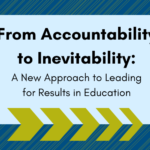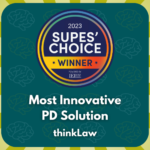This week, thinkLaw heads to the Texas Association for the Gifted & Talented’s giftED18 conference. In our sessions, we will share why thinkLaw is committed to serving gifted learners with the same level of passion, commitment, and resources as we do for our students facing the most barriers to education success. Click here for information about thinkLaw founder and CEO Colin Seale’s giftED18 sessions.
I had the privilege of being identified as a gifted learner in first grade. For too long I’ve been apprehensive to talk about why I consider gifted education a crucial equity issue. I spent the last 15 years as a fierce educational equity advocate, both inside and outside out of the classroom. In all that time, giftedness was – and continues to be – simply not a priority. As a teacher with Teach for America, my eyes ]opened to the madness of fourth graders in low-income communities already being two to three grade levels behind their higher-income peers. My teaching experience made me even more enraged about the severe inequities for our English Learners and students receiving special education services. With the massive, systemic odds stacked against so many students in low-income communities just to meet minimal proficiency requirements, I spent most of my career ignoring gifted students when it came to my time and my schools’ limited dollars and resources.
See how critical thinking can unleash the full potential of ALL of your students. Contact thinkLaw for a customized quote.
I, like far too many educators, bought into the fundamentally unfair myth that gifted students “will be just fine.” This is simply not true, especially for students whose giftedness intersects with their socio-economic status, race, home language, and other traits that leave gifted learners under-identified and underserved. We are long overdue for the moment when the most hardcore education-for-all advocates recognize our systemic lack of support for gifted learners as an urgent equity issue. To help shift this mindset, I want to break down 1) how supporting gifted and talented learners aligns with the true purpose of education; 2) the social cost of failing to identify and adequately serve gifted learners; and 3) why supporting gifted learners raises the bar for all students.
Education’s Mission: Unleash the full potential of all students.
The best part of partnering with schools in fifteen states to help their educators teach critical thinking to all students is I get to learn what ignites the fire in the belly of teachers and administrators across the country. When I hear these passionate leaders share how they would design education if they had unlimited resources, a consistent educational philosophy emerges from New York City to rural Arizona. This philosophy is grounded on the ideal that schools should unleash the full potential of every single student. This is uncontroversial, just like it’s uncontroversial to ensure that we provide special services and support to remove barriers for students who would not reach their full potential otherwise. But if education is about unleashing the full potential of all students, why would we settle for anything less for gifted learners?
We do not say gifted and talented athletes “will be just fine.” We do not say that gifted and talented artists and performers “will be just fine.” We strive to find and fund opportunities to give these students a platform to challenge them, make them better, and unleash their full potential. And we do this even though the number of potential scholarship athletes and entertainment stars amount to just a fraction of the 3 million plus identified gifted and talented learners across the country. I get that identifying academic giftedness in children is often far more complex than “that girl can ball” or “that boy can sing.” But our failure to equitably identify giftedness in diverse student populations does not let us off the hook. We must commit to serving gifted learners with the same level of passion, commitment, and resources as we do for our students facing the most barriers to education success.
Failing Our Gifted Students: The Massive Social Costs
Before I was identified as a gifted student, I struggled with all sorts of behavior challenges in my first grade class in Brooklyn. The cycle looked something like this: teacher gives us work, I finish it in two minutes, I start messing around and playing with kids who weren’t done with their work, I get in trouble, I get more busy work as “punishment.” On a good day, my teacher might use me as her “helper,” because rather than teaching me more material or offering me more deeper learning experiences through challenging extension activities, it made more sense to make me teach students things I already knew. And as a teacher, even though I knew how destructive these practices were, I did the same exact thing with my gifted learners because I was never trained to support their needs.
None of this really hit home until I met the brightest young man I’d ever come across. He was an amazing problem solver and super-creative thinker, but here’s the thing: this 17-year-old was not in my math class and his problem wasn’t about graphing polynomials. He was my client in my law school’s juvenile justice clinic, and his problem was trying to figure out how to beat adult charges after his arrest on a serious drug bust one month before his 18th birthday. This young man brought to life the findings of the largest study ever on incarcerated gifted students, which revealed that 15 percent of incarcerated youth tested in the top 3 percentile on standardized intelligence scales. This young man was the perfect example of the type of student gifted programs too often overlook. He was an immigrant, English was not his first language, he grew up in poverty, and lived on his own since he was thirteen. When we don’t create spaces to recognize and support the genius of all young people, they are at an increased risk of creating their own spaces to stand out, often with serious negative ramifications.
But even when gifted learners are properly identified, we set them up for failure when we do not train their teachers to support them. This training must recognize that about six percent of students receiving special education services are “twice-exceptional.” So while they may have learning differences, they are also academically gifted. Teachers must also understand that many gifted learners struggle with asynchrony. I remember an observation I conducted of a gifted second grader: “You read at a 10th grade level, why are you eating your boogers?” Gifted learners also are not equally gifted across all academic disciplines. And most importantly, gifted learners are not necessarily high achieving students (and vice-versa). In fact, when teachers are not equipped to meet the special needs of gifted learners, and overly rely on rote memorization and drill and kill strategies, gifted students are often more likely than their peers to check out.
Shatter the Achievement Ceiling: Raise the Bar for All Students
Opposing teams could not defend against slam dunks by UCLA’s 7’2” center Kareem Abdul-Jabbar (then named Lew Alcindor) and other incredibly gifted athletes, so the NCAA decided to ban dunks for several years from 1967-1977. Less than 10 years later, the 5’7” Spud Webb (whose hands were not large enough to palm a basketball) defeated his teammate, the 6’8” “Human Highlight Reel” Dominique Wilkins in the NBA’s Slam Dunk Contest. Twenty years later, Spud Webb trained the 5’9” Nate Robinson to win the slam dunk contest and he took home first place three times in five years.
I wanted to share this anecdote because we often recognize that strategic scaffolds for English Learners and students receiving special educational services help all students. But we less often understand that differentiation for gifted learners has a similar effect. This is why some schools looking to increase rigorous learning opportunities for all students require and pay for all of their teachers to receive an endorsement in gifted education. Education equity can’t just be about closing achievement gaps. It must be about shattering achievement ceilings, and prioritizing gifted education is a key strategy for unleashing the full potential of all students.








Leave a Reply